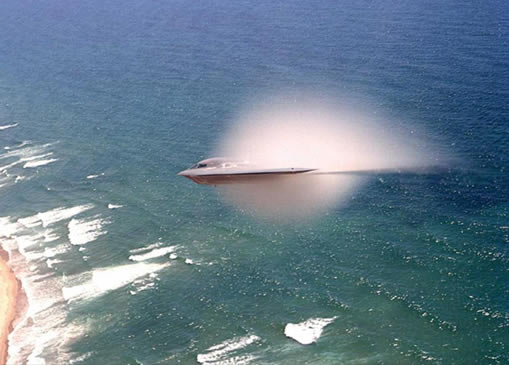
THE BELOW LINKS CONTAIN DETAILED AIRLINE, MILITARY JETS, TEST AIRCRAFT, AIRPLANE FACT SHEETS AND AEROSPACE INFORMATION THE BELOW LINKS CONTAIN AVIATION, MILITARY, AIRCRAFT VIDEOS, PICTURES, FACTS, INFORMATION, AUDIO, HISTORY, MOVIES AND PHOTOS 
THE BELOW LINKS CONTAIN FLIGHT TRACKING, AIRPORT INFO, AVIATION PIONEERS, USAF REFERENCES, NTSB FACTS AND AVIATION WEATHER |
THE SPEED OF SOUND FACTS PICTURES AND INFORMATION
(The atmospheric model for the speed of sound at sea level is 761.18 mph (661.32 knots) - This speed is referred to as MACH 1)
CLICK HERE FOR A SONIC BOOM WAV SOUND FILE
Sound is a vibration that travels through an elastic medium as a wave.The speed of sound describes how much distance such a wave travels in a given amount of time. In dry air with a temperature of 21 °C (70 °F) the speed of sound is 344 m/s (1230 km/h, or 770 mph, or 1130 ft/s). Although it is commonly used to refer specifically to air, the speed of sound can be measured in virtually any substance. The speed of sound in liquids and non-porous solids is much higher than that in air. Dependence on the properties of the medium Implications for atmospheric acoustics Basic concept In a real material, the stiffness of the springs is called the elastic modulus, and the mass corresponds to the density. All other things being equal, sound will travel more slowly in denser materials, and faster in stiffer ones. For instance, sound will travel faster in iron than uranium, and faster in hydrogen than nitrogen, due to the lower density of the first material of each set. At the same time, sound will travel faster in iron than hydrogen, because the internal bonds in a solid like iron are much stronger than the gaseous bonds between hydrogen molecules. In general, solids will have a higher speed of sound than liquids, and liquids will have a higher speed of sound than gases. Some textbooks mistakenly state that the speed of sound increases with increasing density. This is usually illustrated by presenting data for three materials, such as air, water and steel. With only these three examples it indeed appears that speed is correlated to density, yet including only a few more examples would show this assumption to be incorrect. Mach number Aircraft flight instruments, however, operate using pressure differential to compute Mach number; not temperature. The assumption is that a particular pressure represents a particular altitude and, therefore, a standard temperature. Aircraft flight instruments need to operate this way because the impact pressure sensed by a Pitot tube is dependent on altitude as well as speed. |
© AviationExplorer.com - The Website For Aviation Enthusiasts |




